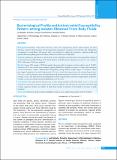Please use this identifier to cite or link to this item:
https://hdl.handle.net/20.500.14356/1381Full metadata record
| DC Field | Value | Language |
|---|---|---|
| dc.contributor.author | Shrestha, Lok Bahadur | - |
| dc.contributor.author | Bhattarai, Narayan Raj | - |
| dc.contributor.author | Khanal, Basudha | - |
| dc.date.accessioned | 2023-05-09T08:12:11Z | - |
| dc.date.available | 2023-05-09T08:12:11Z | - |
| dc.date.issued | 2019 | - |
| dc.identifier.citation | ShresthaL. B., BhattaraiN. R., & KhanalB. (2019). Bacteriological Profile and Antimicrobial Susceptibility Pattern among Isolates Obtained From Body Fluids. Journal of Nepal Health Research Council, 17(2), 173-177. https://doi.org/10.33314/jnhrc.v0i0.1656 | en_US |
| dc.identifier.issn | Print ISSN: 1727-5482; Online ISSN: 1999-6217 | - |
| dc.identifier.uri | http://103.69.126.140:8080/handle/20.500.14356/1381 | - |
| dc.description | Original Article | en_US |
| dc.description.abstract | Abstract Background: Infections of the sterile body sites, when occurs typically have greater clinical urgency and these infections could be life threatening. For the appropriate management of patient, early detection and identification of organism is crucial. Hence, the present study was designed to evaluate the prevalence, organism profile and antimicrobial susceptibility pattern of isolates obtained from infection of body fluids. Methods: Laboratory and clinical records of all the sterile body fluid except blood and cerebrospinal fluid submitted to the Department of Microbiology, B. P. Koirala Institute of Health Sciences during the period of 5 years (January 2012 to December 2016) were analyzed. Results: Among 1835 samples, 196 fluids samples showed growth of organisms with an isolation rate of 10.68%. Escherichia coli (E. coli) was the most common organism followed by Staphylococcus aureus (S. aureus) and Acinetobacter calcoaceticus-baumannii complex. Antimicrobial susceptibility testing showed variable degree of resistance. Thirty percentage of organisms were multi-drug resistant, 10% were extensively-drug resistant, none was pan-drug resistant, 35% of E. coli and K. pneumoniae were extended spectrum ?-lactamase producer and 30% of S. aureus were methicillin-resistant S. aureus. The study showed increasing trends of multi-drug resistant, extensively-drug resistant, methicillin-resistant S. aureus and extended spectrum ?-lactamase over the years. Conclusions: The study showed infection rate of 10% among normally sterile body fluids. E.coli, S. aureus and Acinetobacter calcoaceticus-baumannii complex are the common organisms. The infections are associated with multi drug resistant organisms. Routine surveillance of multi-drug resistant in infection of body fluids is necessary to guide treatment. Keywords: Extensively-drug resistant; methicillin-resistant S. aureus; multi-drug resistant; sterile body fluid | en_US |
| dc.language.iso | en | en_US |
| dc.publisher | Nepal Health Research Council | en_US |
| dc.relation.ispartofseries | Apr-June, 2019;1656 | - |
| dc.subject | Extensively-drug resistant | en_US |
| dc.subject | Methicillin-resistant S. aureus | en_US |
| dc.subject | Multi-drug resistant | en_US |
| dc.subject | Sterile body fluid | en_US |
| dc.title | Bacteriological Profile and Antimicrobial Susceptibility Pattern among Isolates Obtained From Body Fluids | en_US |
| dc.type | Journal Article | en_US |
| local.journal.category | Original Article | - |
| Appears in Collections: | Vol. 17 No. 2 Issue 43 Apr - Jun 2019 | |
Files in This Item:
| File | Description | Size | Format | |
|---|---|---|---|---|
| 1656-Manuscript-10741-1-10-20190804.pdf | Fulltext Download | 359.78 kB | Adobe PDF |  View/Open |
Items in DSpace are protected by copyright, with all rights reserved, unless otherwise indicated.
